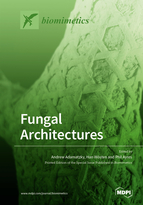Fungal Architectures
A special issue of Biomimetics (ISSN 2313-7673). This special issue belongs to the section "Biomimetics of Materials and Structures".
Deadline for manuscript submissions: closed (1 April 2023) | Viewed by 89743
Special Issue Editors
Interests: unconventional computing; fungal computing; reaction-diffusion computing; cellular automata; physarum computing; massive parallel computation; applied mathematics; collective intelligence and robotics
Special Issues, Collections and Topics in MDPI journals
Interests: mushroom formation; fungal materials; fungal cell factories; fungal
Special Issue Information
Dear Colleagues,
Against a context of resource depletion, resource scarcity and projections of a surging increase in material demand over the coming decades, fungal materials offer a promising realm for expanding our material base. In this rapidly developing field, research has predominantly focused on the protocols of production and properties of denatured fungal materials. This remains a rich field of investigation with many emerging perspectives that promise to enhance and expand potentials for application.
In addition, new research perspectives are enriching the field of fungal materials by drawing upon understandings of the role fungi have played in the shaping and maintenance of Earth’s ecosystems; the roles they play as regulating networks for interspecies communication within forests; and of the fact that fungi demonstrate a high degree of proto-intelligence and show evidence of long-distance communication within their extended bodies, including decision making. This nascent research territory is predicated on working with and maintaining the living organism, with early studies focusing on the sensorial physiology of fungi and the analysis of the computational potential of mycelium networks.
In this Special Issue, we seek to bring together current research trajectories, with the anticipation that this can stimulate cross-over and the further enrichment of the field by exposing interfaces and methods for linking these efforts. We invite biologists, mycologists, material scientists, computer scientists, engineers, architects, physicists, and those from other disciplines to present results of their research within the field of fungal materials.
This Special Issue will open new horizons and research perspectives relevant to bio-fabrication and provide a body of insight that can spur developments in the design and synthesis of intelligent fungal architectures.
Topics considered include but are not limited to:
- Chemical, mechanical and optical sensing of fungi;
- Communication and information transfer in fungal networks and ecosystems;
- Fabrication of pure mycelium materials and mycelium-bound composites and their applications;
- Construction approaches for large-scale structures;
- Functional grading and tuning of properties in mycelium-bound composites;
- Modelling and simulation of fungal dynamics and/or fungal materials;
- Methodologies for characterizing living fungal materials;
- Enhancing the durability of fungal materials;
- LCA of fungal materials.
Prof. Dr. Andrew Adamatzky
Prof. Dr. Han Wösten
Dr. Phil Ayres
Guest Editors
Manuscript Submission Information
Manuscripts should be submitted online at www.mdpi.com by registering and logging in to this website. Once you are registered, click here to go to the submission form. Manuscripts can be submitted until the deadline. All papers will be peer-reviewed. Accepted papers will be published continuously in the journal (as soon as accepted) and will be listed together on the special issue website. Research articles, review articles as well as short communications are invited. For planned papers, a title and short abstract (about 100 words) can be sent to the Editorial Office for announcement on this website.
Submitted manuscripts should not have been published previously, nor be under consideration for publication elsewhere (except conference proceedings papers). All manuscripts are thoroughly refereed through a single-blind peer-review process. A guide for authors and other relevant information for submission of manuscripts is available on the Instructions for Authors page. Biomimetics is an international peer-reviewed open access quarterly journal published by MDPI.
Please visit the Instructions for Authors page before submitting a manuscript. The Article Processing Charge (APC) for publication in this open access journal is 1600 CHF (Swiss Francs). Submitted papers should be well formatted and use good English. Authors may use MDPI's English editing service prior to publication or during author revisions.
Keywords
- fungi
- biomaterials
- unconventional computing
- bio-hybrid architecture
- living architecture
- biosensors
- fungal materials
- mycelium materials
- intelligent materials
- engineered living materials
- bio-fabrication
- construction integration









